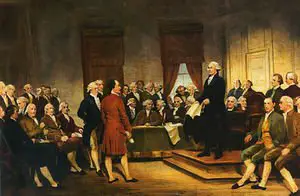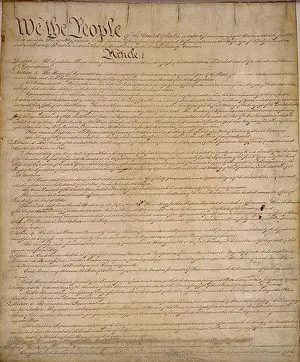Was the Constitution Pro-Slavery
Context
Most historians of the Constitutional Convention locate its origins in the desire for a stronger federation. The Articles of Confederation had proven to be weak following its passage by the Continental Congress. The convention featured delegates from the states, which have been broken down into those states with large populations and those with small, and at another level those states who represented the deep south, the middle south, and the north. These gradations, if you will, would prove essential to understanding the makeup of the Constitution and the interests that were served.
At its most basic level, the Constitution served to enact a system of governance and delegation of powers. The questions that guided the framers included but were not limited to, questions of decision-making power, the functions of the central state, and question of elected representatives and how they might be chosen. The selection and separation of powers preceded concerns about individual rights, which would prove critical to the United States as well. (The Bill of Rights was added to the document in 1791). One reading of the reasons for these concerns might emphasize that what guided the thinking of the framers was naked interests. [1]
If there is any plausibility to this line of reasoning, then, it would stand to reason that the question of slavery would garner much concern. Particularly, given the ways in which resistance to slavery was inscribed in both the American Revolution and the other key document, the Declaration of Independence. Historians report that what made much of the debate so raucous, were the ways in which the interests of the small Northern states aligned with the Deep South against the middle states. [2]
Yet, the world “slavery” never appears in the document. There has been much speculation about why, but as the pre-eminent historian on this question, David Waldstreicher has pointed out, that while the world slavery is omitted, enslaved people were not. In his book, Slavery’s Constitution: From Revolution to Ratification (2009), Waldstreicher points out the ways in which the peculiar institution informed and was reflected by the thinking of the framers.
The Three-Fifth’s Compromise
The much discussed and debated three-fifths compromise was a critical one in the context of the Constitutional Convention. While there are those who cite it to show that America at its outset sought to deny the citizenship, and the very humanity of enslaved persons, its actual use was much more complicated than that.
The question of counting enslaved people as “three-fifths” of a person was decidedly about the taxation and representation. Fearful of the power of larger states, slave states vied for assuring that their political interests would be protected by asserting that “persons held to service” be counted. This immediately added to the number of representations that would be gained from southern states, as the House of Representatives was formed through proportional representation. Article I, Section 2 reads “Representatives and direct Taxes shall be apportioned among the several States which may be included within this Union, according to their respective Numbers, which shall be determined by adding to the whole Number of free Persons, including those bound to Service for a Term of Years, and excluding Indians not taxed, three fifths of all other Persons.” [3]
Arguing against the compromise were those who few who held antislavery beliefs. But those representing states like South Carolina and Georgia had threatened to walk out of the Convention, without this key compromise. As such, it was adopted. While counting enslaved peoples as one person might have seemed desirable on its face (especially to those today, who saw it as some moral wrong to count enslaved people as three fifths), the reality was that it would have further strengthened the south, which was so committed to the institution of slavery.
Counting enslaved people was both an acknowledgment that they were people and property. As scholars have pointed out, this was not a marginal issue. Any time the question of representation in the federal legislative body or the issue of taxation was raised, such questions became fundamentally ones that were about the United States’s status as a slave nation, and the extent to which it would go to protect that status. Abolition was never considered.
The Abolition of the Slave Trade
The abolition of the slave trade to the United States, however, was a wholly different matter. In order to understand that context, it is critical to take note of the changing nature of the economies of slavery in the United States. Critical to this shift was the state of Virginia. There, tobacco planters faced the daunting fact of the depletion of the lands in the Tidewater and Piedmont regions of the state. This left the critical mass of enslaved persons without plants to cultivate and led to the attempt to generate a market of for skilled enslaved laborers and other forms of bonded work. This shifted the locus of enslavement, in some cases, from the rural settings to the cities. The consequence was a lower level of security, as the city became a place to more effectively launch rebellions.

The Virginia delegation then, had much to gain from the abolition of the slave trade. On the one hand, it would staunch the flow of native Africans from the region while opening up an internal market for the movement of enslaved people to the South. The coffle was to replace the slave ship. In order to convince others in the delegations that something needed to be done, antislavery delegates floated the idea of taxing slave ship imports. This was thought to not only increase the coffers of the central government, but to dissuade the destabilizing influence of “saltwater Africans” in the nation. The fugitive slave advertisements were generally full of warnings that such African-born enslaved persons were far more willing to participate in domestic insurrections—the danger of which greatly concerned many of the framers. Ultimately, the idea of taxation fell through. (Perhaps the battles of over taxation with Great Britain were too fresh in their memories).
While the interests of the deeper South states were geared towards maintaining the slave trade, a compromise was reached that retained the trade for twenty more years, with the abolition scheduled to occur in 1808. While this came to pass, it is critical to point out the many enslaved Africans entered the United States illegally up until the 1860s.
The Fugitive Slave Clause
The final connections between enslavement and the Constitution was the Fugitive Slave Clause which was implicitly about the nature of federalism. Essentially, the Constitution—and American generally—was concerned with the best means for the state to protect the property, and thus economic viability of its citizens. For this reason, as is well known, only property-holders were given the franchise. This centering of property necessarily had to contend with the vexing question of the enslaved and how best to create protections around “this species of property.”
The fugitive slave clause was such an attempt. It created recourse for individuals in particular states to recover their human “property” in other states. Article IV states, “No Person held to Service or Labour in one State, under the laws thereof, escaping into another, shall, in Consequence of any Law or Regulation therein, be discharged from such Service or Labour, but shall be delivered up on Claim of the Party to whom such Service or Labour may be due.” [4]
Article IV includes other mentions of the relationship between federal protections of property and the issue of slavery. But arguably, the idea that federal government would provide protections for the institution of slavery was one of the most consequential features of the compact. It rendered the Constitution in the eyes of many abolitionists as an irrevocably pro-slavery document. The subsequent fugitive slave laws would sharpen the intent embedded in this clause and would send the nation spiraling into the conflagrations of Civil War.
The Constitution as Pro-Slavery
The great debate among abolitionists in the nineteenth century was whether or not slavery was a pro-slavery document. Activists like William Lloyd Garrison that it was and that the United States required a fundamental rethinking of its charter. Others, like Gerrit Smith and Frederick Douglass argued the opposite. They suggested that the document was intent, never meant to endorse racial slavery. This set the framework for how to wage political struggles against slavery. Black abolitionists like Martin Delany and others, particularly after the Fugitive Slave Law of 1850, would increasingly places less, if any, emphasis on the ability of the Constitution to protect their status. The legacy of the constitution and slavery is fraught with the complexities of the very liberal democracy that was a product of America’s settler colonial foundation.
Waldstreicher argues that: “The compromises of 1787 welded together two dimensions of the politics of slavery: slavery as a form of governance over certain people, and slavery as an economic institution. Even to contemplate, much less codify, this much governance, and that much economic regulation, was itself risky after a revolution against imperial governance and regulation. In the end, the founders used slavery to limit government while allowing slaves to be governed both locally and nationally. In fewer, smaller ways, slavery was itself limited. More decisively, slavery was alternately winked at and silenced as a subject of political debate and adjudication. In the process, it was not so much forgotten as contained.” [5]
Conclusion
The destruction of slavery ultimately required a constitutional amendment—after a bloody Civil War. The Thirteenth Amendment was ratified after it the Emancipation Proclamation was deemed insufficient a tool to rid the nation of slavery. The need for this amendment implicitly answered in the affirmative that the original compact not only endorsed, but protected slavery. The Thirteenth Amendment began the process of cleansing the nation of its “original sin.” Arguably, it is a process that is ongoing.
Related DailyHistory.org Articles
- Thomas Jefferson, the Founding Fathers and Christianity: Interview with Sam Haselby
- American Legal History Top Ten Booklist
- Why Was the Battle of Antietam a Pivotal event in the American Civil War?
- Why was James Willard Hurst important for legal history?
- How Did the Battle of Culloden Change British and American History?
References
- Jump up ↑ For this discussion, see Michael Klarman, The Framers’ Coup: The Making of the United States Constitution (New York: Oxford University Press, 2016).
- Jump up ↑ David Robertson, The Original Compromise: What the Constitution’s Framers were Really Thinking (New York: Oxford University Press, 2013)
- Jump up ↑ David Waldstreicher, Slavery’s Constitution: From Revolution to Ratification (New York: Hill and Wang, 2009), 4.
- Jump up ↑ Ibid, 8-9.
- Jump up ↑ Ibid, 102.

